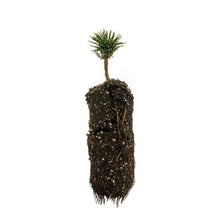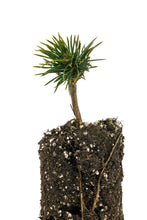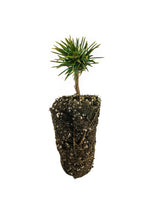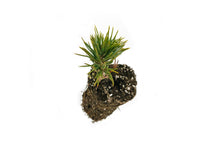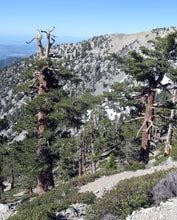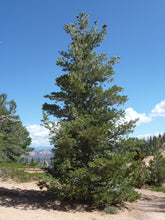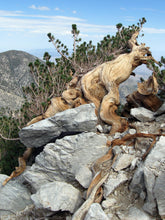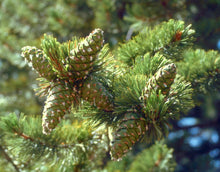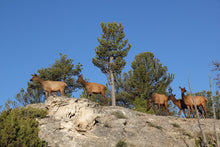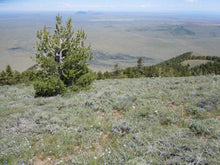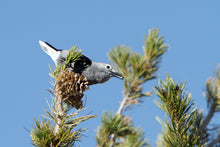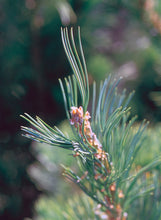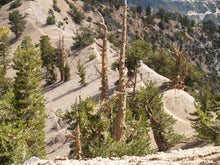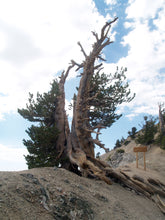
Pinus flexilis
-
The Limber Pine — a slow growing, long-lived species often forming the upper treeline of the central Rocky Mountains — inhabits some of the driest sites capable of supporting trees
- 100% guaranteed
- Seed-grown on California's Redwood Coast
- Transplanting and care instructions included
 |
Moisture Low |
 |
Cold Hardiness -40°F |
 |
Light Full Sun |
 |
Size 30 – 50' tall / 15 – 35' spread |
 |
Lifespan 1,000 yrs |
 |
Growth Rate Slow Growing |
 |
Drought Tolerance High |
 |
Wind Resistance High |
About Limber Pine
From the U.S. Forest Service:
"Limber pine is a slow growing, long-lived species, sometimes taking several hundred years to reach maturity. Mature trees may exceed 1,000 years of age. Limber pine stands are broadly even-aged, though populations also occur in uneven-aged stands and on very harsh sites as widely spaced, isolated individuals. Trees often have an irregular or multi-stem growth form, and rarely reach over 50 feet (15 m). At high elevations they sometimes form krummholz. Trunks may reach 6.5 feet (2 m) in diameter. The species is cold and drought tolerant. Trees are ectomycorrhizal, have deep taproots, and are very windfirm.
Limber pine reproduces entirely from seed; it does not layer lower branches in the soil. Seeds are not effectively dispersed by wind. Small mammals and birds, especially Clark's nutcrackers and pinyon jays, disperse limber pine seeds. The minimum seed-bearing age of limber pine ranges from 20 to 40 years. There are 2 to 4 years between large seed crops. Seeds from krummholz trees have low germination potential.
Clark's nutcrackers have co-adapted an important mutualism with limber pine and are the primary harvester and disperser of its seeds. Limber pine regeneration on burns is largely from germinants of Clark's nutcrackers seed caches. The birds begin harvesting seeds in late August, while the cones are still green and slightly closed. They remove the cones by pecking them loose, fly them to perches, and peck between the scales to remove the seeds. As cones begin to open on the trees in September, Clark's nutcrackers remove exposed seeds. An individual bird can store as many as 125 seeds in its sublingual pouch, then flies to a cache area and deposits numerous caches from its pouchful of seeds. In a burned-over area in northern Utah, Clark's nutcrackers cached an estimated 12,140 seeds per acre (30,000/ha) in 1 year.
Limber pine grows across a wider range of elevations that any other tree species in the central Rocky Mountains, inhabiting some of the driest sites capable of supporting trees. In many high-elevation sites it occupies or forms the upper treeline, but in northern parts of its range it is found at low elevations along plains grassland edges. It typically occurs on steep, rocky, well-drained, windswept, and nutrient-poor sites on exposed ridges and summits. Limber pine is often reported growing on calcareous soil. It is also reported on soils derived from many other types of parent material.
Site preference often separates limber pine and whitebark pine, which is ecologically similar in many respects. Limber pine has a wider geographical distribution and altitudinal range than whitebark pine. Relative to whitebark pine, limber pine occurs on warm, dry sites at low and middle elevations. Where their ranges overlap, the 2 species sometimes grow together on droughty soils. Occasionally, limber pine grows at higher elevations than whitebark pine. South of the range of whitebark pine in California, Colorado, Nevada, and southern Wyoming, the more drought-resistant limber pine replaces whitebark pine and may form the alpine treeline."
About Jonsteen's Seedlings
All of our trees are seed-grown at our nursery on California's Redwood Coast, which is inspected monthly and licensed by the California Department of Agriculture. Trees can provide a natural barrier against high winds, temperatures, noise pollution and soil erosion, all while benefiting local air quality, wildlife and property values — a Jonsteen seedling will only grow in value and beauty!
About Jonsteen's 100% Guarantee
All of our trees are guaranteed to arrive healthy and in good condition. If your tree perishes despite your honest efforts, we will be happy to replace it with a small-sized seedling for just the cost of shipping/handling. You can learn more about our guarantee and tree replacement policy here.
Seedling Size Chart: Medium
Due to the dynamic nature of actively growing trees, as well as the tremendous variation between species’ growth rates, we rely on the cubic volume of a seedling’s root mass to determine its “size” (Small / Medium / Large / XL). Within each size there is minor variance — the dimensions provided here represent the category minimum. If exact measurements are essential, please contact us about current stock.















